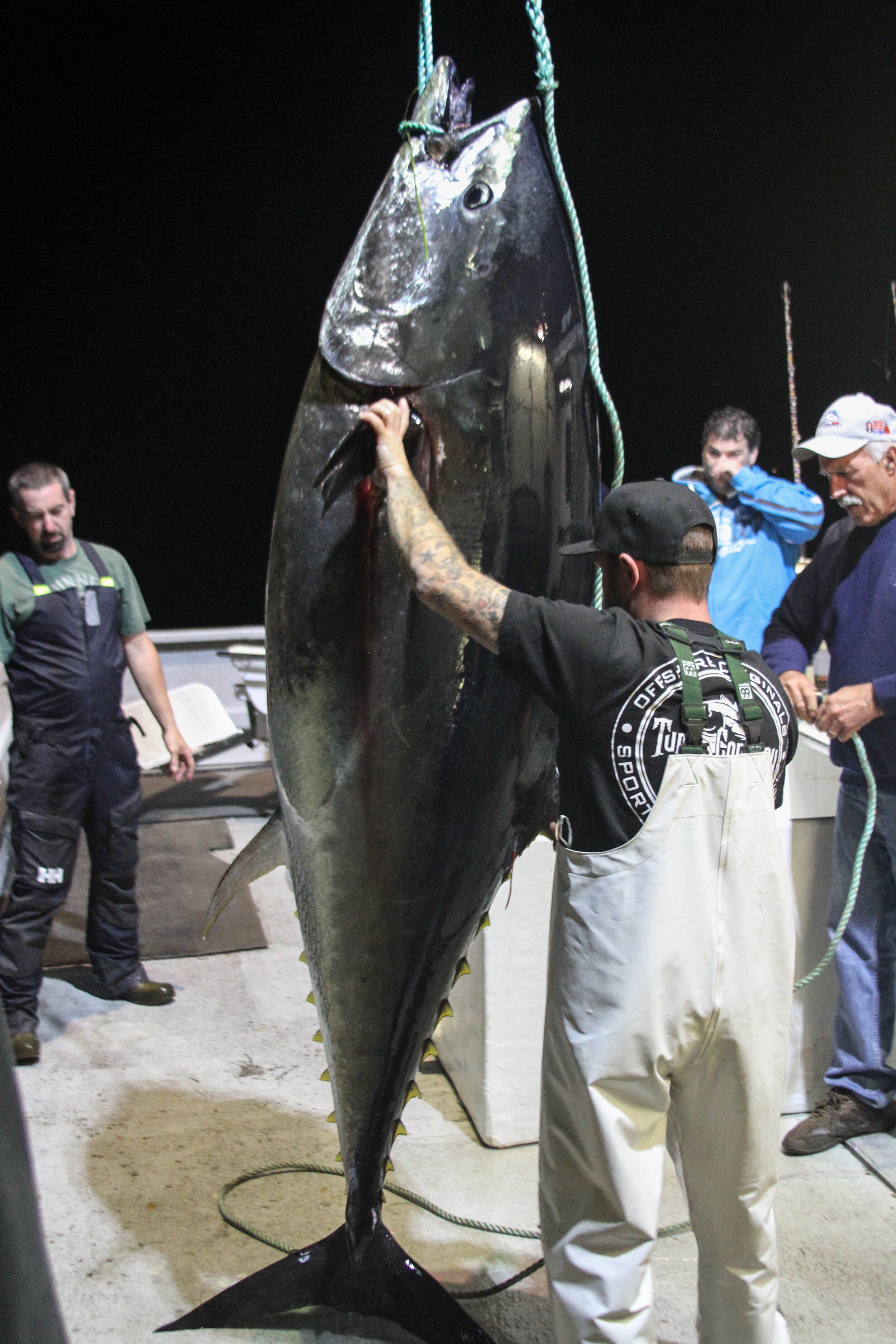Western Atlantic Bluefin Tuna: From Tags up to Tail Cuts
Giant Atlantic bluefin tuna being tagged for LPRC’s Tag A Tiny™ Program. Photo by Michele Heller.
Hi there! My name is Michele and I hail from America’s oldest seaport, Gloucester, Massachusetts. I work for the Large Pelagics Research Center (LPRC), which works closely with fishermen and uses state-of-the-art technologies to conduct research on species of interest.
The U.S. eastern seaboard is home to the largest tuna of them all - the Atlantic bluefin (Thunnus thynnus). This species has a fascinating history - first ignored, then obsessed over, and now coming closer to a sustainable balance between fishing and conservation. I came to know this species both through my scientific work at the LPRC, and through seafood, by taking home the tail cuts of these giant fish for dinner, which are considered ‘waste’ by processors looking to sell just the fillet loin cuts to the sushi market.
LPRC conducts biological and ecological research on pelagic species including tunas, sharks, billfish, and sea turtles. The center endeavors to develop scientific understanding that supports effective ecosystem-based management strategies for highly migratory Atlantic marine species.
LPRC’s Tag A Tiny™ program is a cooperative Atlantic bluefin tuna conventional tagging program. The Atlantic bluefin is the largest member of the tuna family, reaching weights of over 1000 pounds, and growing to be upwards of 15 feet long.
The program enlists the help of all fishermen (recreational, for-hire, and commercial) to catch, tag and release juvenile bluefin tuna. Tuna are tagged just below the second dorsal fin, ranging in age from one to four years old, and have included a number of giants that are at or over 6 feet long (73 inches). Since the program’s inception in 2006, over 1,800 volunteer anglers have tagged and released nearly 2,000 Atlantic bluefin tuna!
The Tag A Tiny™ program represents the largest conventional tagging effort for juvenile bluefin in the Western Atlantic, as well as a valuable cache of fisheries data. Of the 2,000 bluefin tagged as juveniles, about 40 were recaptured in the Mediterranean a decade later!
Giant bluefin tuna to be sold and shipped to Tokyo from Nova Scotia, Canada. Photo by Michele Heller.
This data from tagged fish shows that juvenile Atlantic bluefin tuna make trans-oceanic migrations across the temperate and tropical regions of the Atlantic Ocean (Gardieff, 2015). The more bluefin that are tagged and tracked, the more information can be gathered to help support fisheries information for this valuable species.
Bluefin are the most prized of the tuna species, valued for both their meat and as a formidable recreational game fish. Prior to the 1970’s, bluefin was highly regarded as a game fish, but both the Japanese and Americans long considered it inedible for humans due to the strong flavor and high fat content of the fish. Historically, it was used as cat food or thrown overboard (Bland, 2015).
As the Japanese became more accustomed to eating beef that was strong in flavor, dark in color, and high in fat content, the appetite for bluefin tuna increased. With the help of a Japanese airlines shipping scheme and new refrigeration technology, bluefin’s popularity in the Japanese sushi industry began to rise (Bland, 2015). Today, bluefin tuna, and especially the fatty tuna belly cut, toro, is considered to be the most highly desired and esteemed type of sushi available.
As demand for fatty bluefin tuna increased, the fishing effort also increased. Historical, selective fishing practices, such as harpoon fishing and fishing with rod and reel, gave way to large scale, extremely effective industrial techniques like purse seine and longline fishing (Conathan, 2012). These new industrial approaches caught more fish, more efficiently.
New refrigeration options were introduced in the 1970s, expanding shipping options. With refrigerated holds, fishing boats, trucks, and planes began to provide fresh bluefin tuna caught in the Atlantic and the Eastern Pacific to Japan (Bland, 2015). Greater demand for bluefin also meant higher market prices, which created a very lucrative fishery. Suddenly, between 1970-1998, bluefin tuna were the most expensive, most sought-after fish in the world (Bland, 2015; Narula, 2014). Bluefin stocks worldwide, at the start of the decade around 2010, began to show signs of overfishing, as their populations were decimated to feed the growing demand (Narula, 2014).
Close-up view of the skin of a freshly landed Atlantic bluefin tuna. Photo by Michele Heller.
Fast forward to present day, and the Western Atlantic stock of bluefin has made a remarkable rebound in their population status due to the management efforts of NOAA Fisheries through its Atlantic Highly Migratory Species Management Division (HMS), and the International Commission for the Conservation of Atlantic Tunas (ICCAT), which is an intergovernmental organization responsible for the management and conservation of Atlantic tunas (NOAA Fisheries, 2021).
Today, the U.S. East Coast bluefin tuna fishery is one of the most highly regulated and sustainable tuna fisheries. These fishermen catch one bluefin at a time, by hand or harpoon, and each fish caught must measure a minimum of 6 ft in length (73 inches). There is a regulated recreational fishery for Atlantic bluefin less than 6 ft in length (73 inches), but all Atlantic bluefin tuna, whether caught commercially or recreationally, are enforced by strict quotas set by NOAA Fisheries.
While the strict quotas protect the Atlantic bluefin tuna population, they can be financially challenging to the fishermen who rely on healthy stocks. Gathering as much stock information as possible through programs like LPRC’s Tag A Tiny™ cooperative tagging project is so important. These fishery-independent data help us to better understand the movements and migrations of the juvenile bluefin stock’s trajectory.
I love sampling bluefin tuna for three reasons. First, I get to learn new and exciting discoveries about them! How old were they when they were caught? Were they male or female? Did they spawn? Secondly, I get to take amazing macro photos of their skin up close and personal. They are the color of the ocean, especially when they are just caught. And third, I get to bring some delicious “waste” home, aka tail cuts.
The tail is considered too labor intensive to deal with and too time consuming, along with the cheek cuts, collars, and head steaks (a dense wedge of meat above the eyes). All that miscategorized “waste” just ends up in the dumpster.
The next time you enjoy U.S. caught Atlantic bluefin tuna, thank its remarkable comeback story due to a cooperative effort. By getting to know the people and companies who provide your seafood, you can also support ecosystem-based fisheries management.
I also highly recommend seeking out the parts that end up as wasted seafood like tuna tail cuts, or the skin. You’ll have to find a way to get to the source, either a tuna dealer/truck driver, fisheries co-op, or auction house.
These establishments may throw out unwanted parts immediately as they dress (or clean) the fish, leaving little opportunity for you to find them in retail markets. But, if you can get your hands on them, you may be surprised by where your palate leads you!
Here are two approaches for my personal favorite tuna part, the tail meat. These tail meat recipes work for any tuna tail you can get your hands on.
References
Bland, Alastar. “From Cat Food to Sushi Counter: The Strange Rise of the Bluefin Tuna”. Smithsonian.com. 11 Sept. 2015.
Conathan, Michael. “Fish on Fridays: Sustaining the ‘Wicked Tuna.’” Center for American Progress. 30 March 2012.
Gardieff, Susie. “Bluefin Tuna”. Florida Museum of Natural History, University of Florida. 1995-2015.
Office of Sustainable Fisheries. “Sustainable Management Means We Can Have Our Tuna and Eat It Too”. 02 Dec 2019. NOAA Fisheries.
Narula, S.K. “Sushinomics: How Bluefin Tuna Became a Million-Dollar Fish”. The Atlantic. 05 Jan 2014.
NOAA Fisheries. “International Fisheries Organizations”. Accessed February, 2021.
Tag a Tiny™. The Large Pelagics Research Center. Accessed February 2021.





